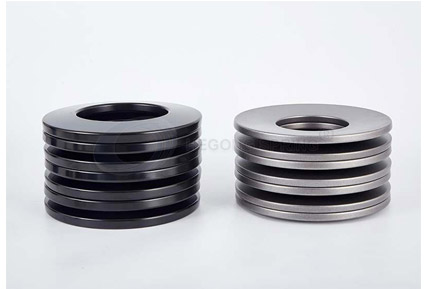Characteristics and classification of disc springs
The disc spring is a washer-type spring with a frusto-conical section made of sheet metal or forged blanks. It is often used in heavy machinery (such as presses) and cannons, aircraft and other weapons, as a strong buffer and vibration damping spring, as a compression spring for clutches and safety valves of vehicles and tractors, and as an energy storage element for motorized equipment.
Features of Disc Springs
1. High rigidity, strong buffering and vibration absorption ability, can withstand large loads with small deformation, and is suitable for occasions with small axial space requirements.
2. With variable stiffness characteristics, this spring has a wide range of nonlinear characteristics.
3. Using different combinations of the same disc spring can change the spring characteristics in a wide range. The combination of involution and stacking can be used, and the combination of different thicknesses and different numbers of sheets can also be used.
When overlapping, the more the number of springs, the greater the load relative to the same deformation.
Application: Disc springs are replacing cylindrical coil springs to a large extent. It is often used in heavy machinery (such as presses) and cannons, aircraft and other weapons, as a strong buffer and vibration damping spring, as a compression spring for clutches and safety valves of vehicles and tractors, and as an energy storage element for motorized equipment.
Disadvantage: The load deviation is difficult to guarantee.
The principle of disc spring
The disc spring is a special spring that is conical in the axial direction and bears the load. After being deformed by the load, it stores a certain potential energy. When the bolt loosens, the disc spring releases part of the potential energy to maintain the pressure between the flange connections. sealing requirements. The stress distribution of the disc spring decreases uniformly from the inside to the outside, which can achieve the effect of low stroke and high compensation force.
 |
| Disc Springs Stack Set |
Classification of Disc springs
Disc springs can be divided into three categories according to the different cross-sectional shapes: including ordinary disc springs (which have a rectangular cross-sectional shape), disc springs with radial grooves, and trapezoidal cross-section disc springs.
Ordinary disc springs are divided into two types: those with supporting surfaces and those without supporting surfaces; disc springs with radial grooves are based on ordinary disc springs, and several evenly distributed grooves are opened along the radial direction. The inner hole is opened in the direction of the outer circle, and it can also be opened from the outer circle to the inner control direction; the trapezoidal section disc spring can be divided into two types: the inner edge thickness is greater than the external aid thickness and the inner edge thickness is smaller than the outer circle thickness.
Since the deformation and load value of the single belleville washer often cannot meet the requirements of use, it can be used in groups to form a disc spring assembly (column). The typical combination methods are: laminated combined disc springs, composite combined disc springs and other combined disc springs.
The main types of disc springs
(1) Ordinary disc springs, trapezoidal section disc springs, conical trapezoidal section disc springs: simple in shape and structure, and widely used. It can be used as a single, butt, stacked or composite disc spring group to withstand static or variable loads, and is used as a strong buffer and shock-absorbing spring in heavy machinery and weapons such as aircraft and cannons.
(2) Diaphragm spring: It is mainly used in automobile clutches, and is composed of two parts: separation finger and disc spring.
(3) Wave washer: It is widely used in mechanical seals, and can be further developed into a spiral wave spring.
(4) Slotted disc spring: usually used in clutches, such as clutches of lathes, automobiles and tractors.
(5) Disc-shaped disc spring: The cross-section is disc-shaped, and it deforms into a truncated cone after being loaded. The structure is simple and the rigidity is large, and it is used for occasions with special requirements.
(6) Coiled disc spring: It has the dual characteristics of disc spring and coil spring, and can obtain different stiffness requirements.
(7) Wave cylindrical spring (wave spring): The wave washer is overlapped into a cylindrical shape, which can obtain a large deformation.

评论
发表评论